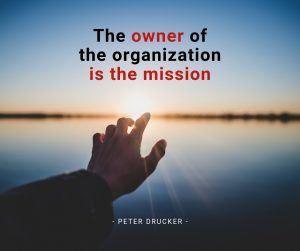How to Develop a Mission Statement in 45 Minutes or Less
 Stephen Covey once said, “The main thing is to keep the main thing the main thing.”
Stephen Covey once said, “The main thing is to keep the main thing the main thing.”
The main thing is what we often call a mission. Using a well-crafted mission statement provides churches with clarity about why they exist. It identifies their purpose and helps them ensure that future actions align with what they believe is of utmost importance—their main thing.
Many leaders tremble at the thought of developing a mission statement. Perhaps they feel intimidated or ill-equipped to lead the process. Or maybe past experiences are clouding their ability to envision a new approach. It’s not uncommon for leadership teams to avoid this work altogether because they don’t believe they have the necessary capacity to complete the task. Thankfully, there’s another way.
I’m going to share a proven method to help groups create a dynamic mission statement. This method works best with 3-12 people, although you can modify it for larger groups.
1. Describe Your Current Group
Begin by describing your current group (if you’re starting a new group, you can pick up the process with the third step when we get there). Have each member of your group brainstorm three to five adjectives that currently describe your group and write them down (you can use post-it notes, paper, or electronic devices).
For example, as I think about the seminary where I teach, three adjectives that come to mind are practical, personal, and collaborative. This time of individual reflection is important. As group members contribute their personal perceptions to the process, they’re much more likely to own the final product—in this case the mission statement—at the end.
2. Categorize the Adjectives of Your Current Group
The second step is to categorize the adjectives that have been developed by your current group. Working together, group these adjectives into categories. For example, someone in my group may have used the word “applied” which we could place in the same category as my contribution of “practical”. Even as you categorize adjectives, don’t minimize the importance of isolated adjectives. The outliers may have an important role to play later on.
3. Describe a Dream Version of Your Group
This step is similar to Step 1, but now each group member is considering what they’d love their group to be like in five years (if you’re starting a new group, this step is your starting point for the mission identification process). Invite participants to write down three to five adjectives that describe this “dream” group.
As I think about the seminary where I work, I would love our group to be more innovative, responsive, and context-based. Once again, this is a solo exercise like Step 1, which helps group members express their voice in a meaningful way.
4. Categorize the Adjectives of Your Dream Group
 As with Step 2, you will categorize the adjectives that team members have shared about your dream group. Categorize these adjectives together. You will find that some may fit into the existing categories you created in Step 2 and others may lead to the creation of new categories. If an adjective doesn’t seem to fit with any of the other descriptions, allow it to stand by itself. Make sure to record your list of adjectives and how you grouped them. This information will inform your discussion of core values, which is the fourth stage of getting the right vision.
As with Step 2, you will categorize the adjectives that team members have shared about your dream group. Categorize these adjectives together. You will find that some may fit into the existing categories you created in Step 2 and others may lead to the creation of new categories. If an adjective doesn’t seem to fit with any of the other descriptions, allow it to stand by itself. Make sure to record your list of adjectives and how you grouped them. This information will inform your discussion of core values, which is the fourth stage of getting the right vision.
5. Create Your Mission Statement
Make the adjectives and categories visible to everyone in your group and then work together to create a one-sentence mission statement. It can begin with something like “We exist to…” or “Our passion or mission is to…”
I worked with a group of students in the past to create a mission statement for the seminary where I teach. Here’s what we developed: “We exist to be a relevant, biblical training ground that seeks to engage current culture in a progressive, collaborative way.” Not bad for under 45 minutes!
6. Shorten Your Mission Statement
The last step is to shorten the length of your mission statement. Try to reduce your sentence to six words or less. You’ll still want to keep your longer mission statement, but it’s helpful to have a shorter version that people can easily remember and share with others.
For example, MB Seminary captures the essence of its larger mission statement in only five words: lifelong learning for lifelong mission.
If you have a larger group of more than 12 people, I’d encourage you to break your group into smaller groups and go through the first five steps. Then, take some people from each of the smaller groups to create a representative group. This group will take the full mission statements and affirm one of them or combine elements from each to create a new one. It would be helpful if the emerging mission statement goes back to the larger group for feedback before the representative group comes up with a shorter statement of six words or less. Alternatively, you can have the original small groups work on the shorter statements before a representative group is established (the drawback is that groups can sometimes develop a strong sense of ownership to these shorter mission statement and it can be difficult to release this when a revised statement is brought back to them).
Final Thoughts
Over the years, I’ve been amazed by how groups can develop amazing mission statements in such a short amount of time. Encourage group members to think and pray about the mission statement draft you’ve created together. Take time to discuss it further the next time you meet and to refine it, if necessary.
Peter Drucker has said, “The owner of the organization is the mission.” This is why it’s so important to carefully discern God’s mission for us—the mission that will guide everything we do.
[Randy Wollf is Associate Professor of Leadership Studies and Practical Theology and Director of the ACTS World Campus.
_
__



